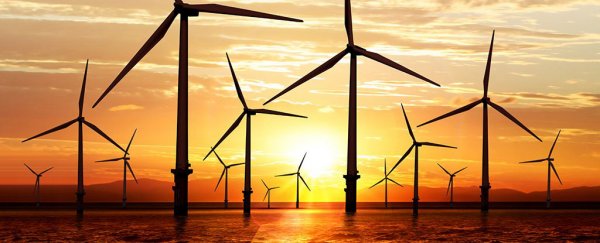Last year was a huge turning point for clean power, with renewable energy surpassing coal to become the largest source of power capacity in the world for the first time, according to a new report.
And not only have renewables now overtaken coal, but the rate of their adoption keeps getting faster. In another first, growth in renewables outstripped all other forms of new power generation in 2015, with clean energy accounting for more than half of the world's new electricity capacity added last year.
The new figures, released in a market report by the International Energy Agency (IEA) this week, mean that energy forecasts from only a year ago now need to be revised – with renewables growth between 2015 and 2021 predicted to be 13 percent greater than estimated last year.
That revised estimate should see renewables be responsible for 28 percent of electricity generation by 2021 – last year, it accounted for 23 percent, so each year, renewables take over about 1 percent of the electricity market.
That 2021 prediction might only be a little over a quarter of the world's total electricity in five years' time, but it amounts to a massive 7,600 terawatt hours – equivalent to the total combined electricity generation of the US and the European Union (EU) today.
And in that five-year timespan, renewables are expected to absorb 60 percent of all power capacity growth, which basically means the IEA doesn't see the record-setting gains shown in the past year slowing down any time soon.
"We are witnessing a transformation of global power markets led by renewables and, as is the case with other fields, the centre of gravity for renewable growth is moving to emerging markets," said IEA executive director Fatih Birol.
In those emerging markets, the rate of renewables adoption is almost unimaginably fast. In China, two new wind turbines were installed every hour in 2015, meaning the nation had built almost 20,000 new turbines by the end of the year.
That flurry of investment saw China soak up about half of all new wind power additions, and approximately 40 percent of global renewable capacity increases in total.
Wind power led the growth in renewables, adding 66 gigawatt (GW) of capacity in 2015, followed by solar, which represented 49 GW.
And just in case you think that means solar's been slacking off, bear this in mind: that additional 49 GW of capacity amounts to about 500,000 new solar panels being installed around the world every day last year.
So obviously there's a lot to celebrate in these new figures, which the IEA puts down to stronger renewables policies – chiefly in the US, China, India, and Mexico – plus falling prices thanks to stronger competition in the marketplace, and better technology.
But the researchers also say we need to make sure the momentum keeps up.
Many countries around the world still aren't getting behind renewables strongly enough, and even in nations that have thrown their support behind clean power – such as China – their increase in renewables capacity still doesn't meet their ever-higher electricity demands.
Whereas in the US, EU, and Japan, additional renewables capacity is expected to outpace electricity demand over the next five years.
The report also shows that the renewables landscape has changed, with industrialised countries – that once led the charge on clean power – losing ground to emerging nations like China and India. By 2021, these two nations alone are predicted to account for almost half of global renewable capacity additions.
"If you think of running a marathon, Europe started with a big advance, more than half of the marathon they are leading by far," Birol told Adam Vaughan at The Guardian. "They are now getting a bit tired, and some others are overtaking Europe slowly but surely."
Even with the massive gains we're making, though, the researchers warn that uptake still isn't happening fast enough for the world to meet the ambitious commitments made at the 2015 UN Paris climate deal, designed to keep rises in global temperature under 2 degrees Celsius by the end of the century.
In other words, we've come a long way on renewables, but there's still a long way to go.
"I am pleased to see that last year was one of records for renewables and that our projections for growth over the next five years are more optimistic," Birol said in a statement.
"However, even these higher expectations remain modest compared with the huge untapped potential of renewables.
The Medium-Term Renewable Energy Market Report 2016 is available online.
